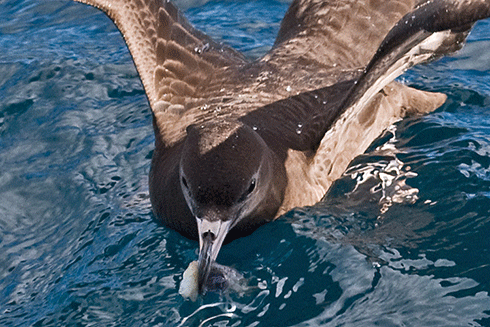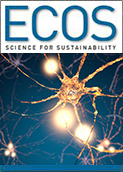
|
Published: 5 May 2014
The science is in: the solution to pollution is not dilution
A nuclear science technique – involving sophisticated instruments sensitive enough to detect the presence of a glass of wine in a volume of water the size of Sydney Harbour – has been used to show the extent of plastic pollution in the marine food chain based on analysis of seabird feather samples.

|
|
A flesh-footed shearwater feeding at sea: seabirds are particularly prone to accidental ingestion of large and small items of plastic debris. Credit:
Tony Morris
|
Professor Richard Banati from Australian Nuclear Science and Technology Organisation (ANSTO) has been collaborating with ecologist, Dr Jennifer Laver from Monash University, to use radioactive tracers and seabird feathers to investigate the issue.
The researchers found elements in the sample feathers from flesh-footed shearwaters similar to those found in plastic pieces in the birds’ digestive systems. This indicates that potentially toxic contaminants, such as cadmium, transfer into the body after ingestion and remain there.
Plastics floating in the oceans have a complex degradation process which makes them potentially more, rather than less, hazardous than previously thought. At one level, small plastic pieces in the stomachs of seabirds are mechanically injuring to the gut. Additionally, as they degrade, plastics (including biodegradable plastics) break down into smaller and smaller pieces, meaning their reactive surface area increases dramatically. This leads to the release of more toxins, such as cadmium and mercury, into the environment.
‘A traditional approach to environment management has been “the solution to pollution is dilution”. However researchers are becoming concerned about this approach,’ said Professor Banati.
‘Specifically we are finding that mass plastic consumption, together with increased degradability of plastics, may actually lead to a steady increase of hazardous contaminants in the environment which would be difficult to reverse.
‘Plastics are a great invention, they are ubiquitous in our lives and they are likely to have an even more important place in our future world – they are the pottery of our age.
‘The issue is that plastic waste may just not be as benign as the Greek amphorae that litter the floor of the Mediterranean Sea. We need to be mindful that remnants of seemingly “single use” items often stay in the ecosystem for a very long time and do not simply disappear, but continue to move through the environment, and the plants and animals therein.
‘What we have done is show that the traceability of plastics, from a scientific perspective, allows an analysis of the life-cycle of plastic that extends well beyond the litter than we can see.
‘There is a clear interconnection between environmental, biological and social issues here, and we’re working to identify what the possible answers are, but also what the questions should be.
‘Should we be further emphasising use of quality, reusable products? Are industry standards for biodegradable plastics appropriate? Should we find a way of further incentivising plastic collection?
‘These are interesting questions and, if anything, what research at the atomic scale shows is that they are at least worth putting out there and discussing.’
Source: ANSTO



